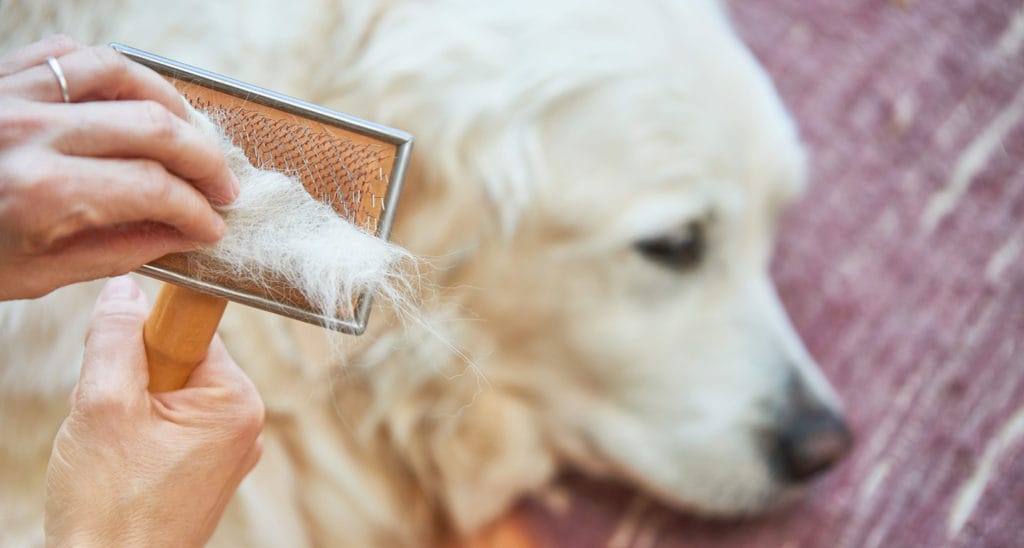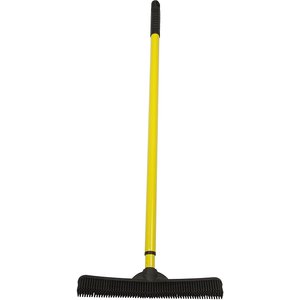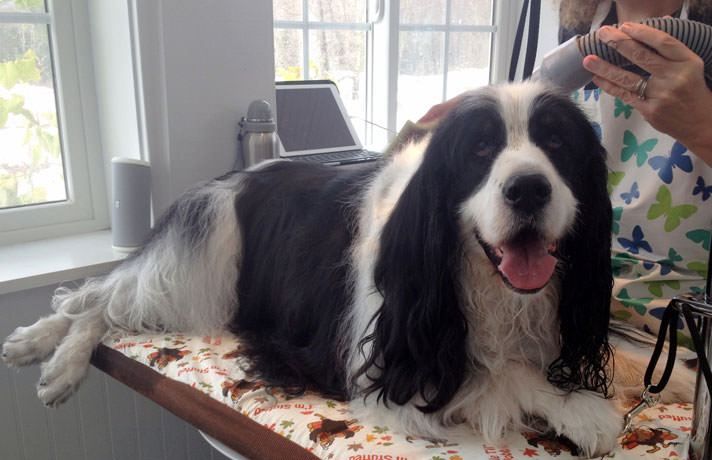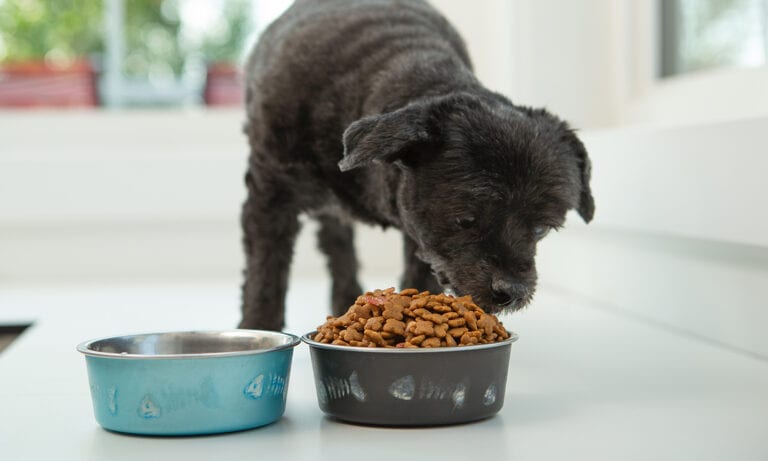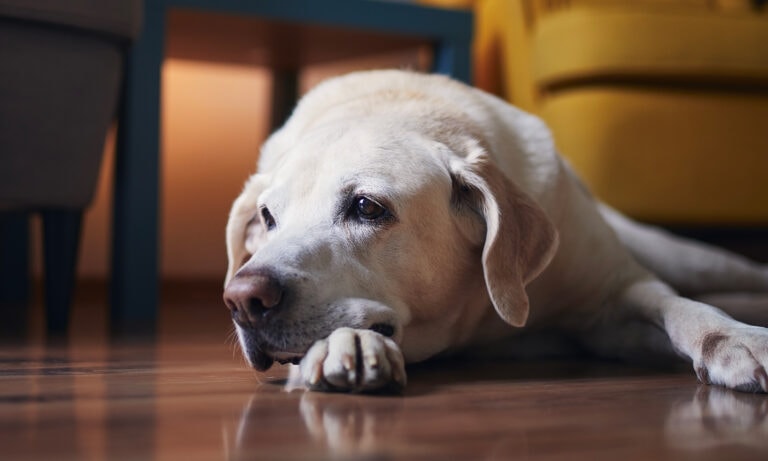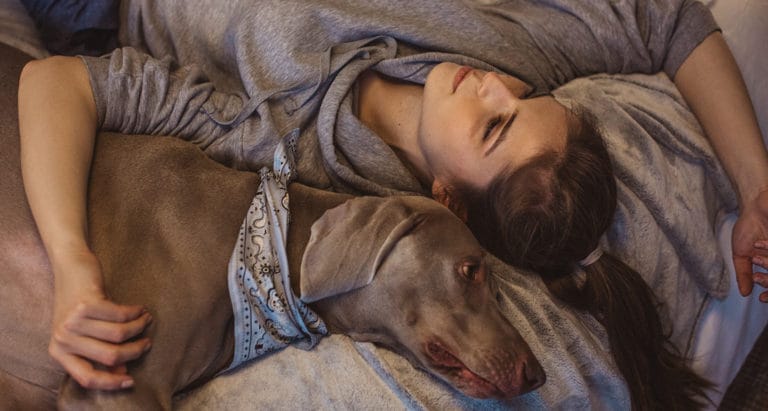If you notice that your old dog is losing hair, it’s natural to become concerned. Senior dogs can lose their hair or fur for a variety of reasons. Hair loss can be normal (what we commonly refer to as shedding) or it can be abnormal (health related). But why is your old dog losing hair? Here, we’ll explore the many reasons why your old dog is losing hair in patches or all over their body, or why your old dog is shedding a lot—and what you can do about it.
Why Is Your Old Dog Losing Hair?
Common reasons for hair loss in old dogs include:
- Seasonal shedding
- Hormonal reasons
- Illness
- Nutritional deficiencies
- Parasites
- Aging
Here's what you need to know about each one:
1 Seasonal Shedding
One reason for old dogs losing hair is seasonal shedding.
“Hair loss, [or] shedding, in dogs is under the control of many factors,” says Jon D. Plant, DVM, DACVD, founder of SkinVet Clinic in Lake Oswego, Oregon. “These include the length of light exposure—including artificial light—ambient temperature and hormonal changes.”
If you notice that your old dog is losing lots of hair through shedding, note that seasonal shedding can be quite dramatic, with dogs losing a lot of their coat in just a few weeks of time. Once or twice a year, certain breeds go through massive seasonal sheds. These big sheds are sometimes called “blowing coat,” and during this time it’s normal to find hair all over your clothes and hair clinging to your couch.
You can invest in home cleaning solutions, like the Bissell Pet Hair Eraser handheld vacuum and FURemover extendable pet hair removal broom, or lint rollers, like the Evercare Pet Plus Extreme Stick lint roller, to combat the issue.
Even if a dog doesn’t massively blow coat, shedding may increase slightly in the spring and summer months as the weather becomes warmer.
“Dogs in North America generally replace hair and shed the most in spring, and hair growth is maximal in the summer,” Dr. Plant says.
After blowing coat, a dog’s hair will appear less fluffy and full than it did before, but you shouldn’t see patchiness or balding.
“When pets undergo normal shedding, hair will fall from the skin uniformly all over, leaving no bare spots,” says Daryl Conner, a certified Petcare DermaTech Specialist, a master pet stylist meritus and owner of Fairwinds Grooming Studio in Appleton, Maine. “So, if the coat looks very thin or bare in spots, it is something that should be addressed.”
2 Hormonal Reasons
If your old dog is losing hair in patches (alopecia), it may be a sign of a hormonal abnormality. These can include:
- Cushing’s disease, in which a dog’s cortisol levels are too high
- hypothyroidism, in which a dog's thyroid levels are too low
- Addison’s disease, which occurs when a dog’s adrenal glands aren’t producing adequate levels of hormones
- Post-pregnancy hormonal fluctuations, in which female dogs lose a lot of hair after giving birth or nursing a litter of puppies
In addition to skin and coat changes, other signs of hormonal issues may include lethargy and weight gain without appetite changes. Talk to your veterinarian if you suspect your dog is losing hair due to a hormonal abnormality.
3 Illness
Senior dogs may start losing hair because of illness, such as:
- Infections of the hair follicle
- Mange mites
- Ringworm and other fungal infections
So how can you know if an illness is to blame? Signs of skin illness and allergies include:
- excessive scratching
- licking affected areas
- biting at the skin
Talk to your veterinarian if you suspect your dog has an illness.
4 Nutritional Deficiencies
An inadequate diet that’s lacking the correct balance of nutrients can lead to hair loss in dogs. The nutritional needs of dogs may change as they age, requiring a diet switch or additional supplements, as recommended by your veterinarian.
“A malnourished dog will divert energy and protein from hair growth to other parts of the body,” Dr. Plant says.
Learn more about senior dog food and how to feed your dog at all life stages.
5 Parasites
If you’re noticing that an old dog is losing hair in patches, it could be due to the manifestation of parasites. These include:
- fleas
- ticks
- mites
Parasitic infestations can cause hair loss as the dog scratches and bites their itchy and irritated skin. Flea bites in particular can trigger allergic reactions in dogs, leading to further skin inflammation and hair loss.
Parasites may be visible on the skin (as in the case of fleas and ticks) or may be invisible to the naked eye (as with skin mites). Dogs infested with parasites are often very itchy and may obsessively scratch or lick their skin. Talk to your veterinarian if your dog shows these symptoms.
6Aging
Sometimes, a senior dog losing hair is just a reflection of the natural aging process. “Some geriatric dogs will develop alopecia or hypotrichosis (thin coat) in the normal course of aging, without identifiable underlying hormonal disease,” Dr. Plant says. In these cases, no treatment is necessary—your dog is still healthy (just a little less fluffy).
How to Identify Hair Loss in Senior Dogs
To get an idea if your senior dog is losing hair because of simple shedding or something more, take a close look at the coat.
- If your dog isn't showing bald spots or irritated skin, that's a good indicator that their hair loss is normal, Dr. Plant says.
- On the other hand, if you can grasp a tuft of hair and pull nearly all of the strands out easily, that's cause for concern.
- Itching, redness and irritation, or bleeding are also signs that something's not right.
Not sure? You can always ask your veterinarian—or even your groomer.
“Groomers are often on the front line when it comes to noticing any changes in the pet’s physical appearance,” Conner says. “In many cases, groomers see the pet every six to eight weeks—far more frequently than the average pet sees their veterinarian. In addition to this, they see every inch of the pet as they bathe, dry and groom them.”
How to Treat Senior Dog Hair Loss
The first step toward treating senior dog hair loss is figuring out what is causing it by taking your dog to the veterinarian for an exam. The vet will take a comprehensive history, asking you questions about the dog’s symptoms.
“Screening for hormonal diseases will include a blood panel,” Dr. Plant says. “The veterinarian may also review the dog’s nutritional status.”
Depending on your dog’s symptoms, other tests might be recommended.
Once the cause of an old dog losing hair has been identified, they might be treated in a variety of ways:
1 Medication
If your dog has an infection, disease or other medical issue, such as Cushing's disease or hypothyroidism, medication might be prescribed to address the root cause of the hair loss. Sometimes simply addressing the underlying medical issue will also address the hair loss.
2 Shampoos
There are several types of shampoos and grooming products that can help with old dogs losing hair:
- Medicated shampoos might be required in the case of skin infections or allergies.
- If the dog’s skin is itchy and/or dry, your veterinarian might recommend bathing them with a moisturizing shampoo.
- There are even shampoos that help decrease shedding, such as FURminator DeShedding Ultra Premium shampoo for dogs.
3 Nutrition
If your dog’s veterinarian is concerned about nutritional deficiencies, they might recommend a diet change.
“A good quality food that provides a high plane of nutrition is important for dogs that have lost substantial hair, which is made largely of protein,” Dr. Plant says.
Blue Buffalo Wilderness Chicken Recipe dry dog food and VICTOR Hi-Pro Plus Formula dry dog food are two best-selling high-protein dog foods that you might want to consider discussing with your veterinarian. Find out more about high-quality dog food.
4 Grooming regimens
If your old dog is shedding a lot and the cause of hair loss is normal seasonal shedding, daily brushing and monthly bathing with a moisturizing shampoo can help cut down on the amount of hair trapped in the coat, and remove shed hair before it ends up all over your house. Specialty grooming products like grooming mitts, such as Mr. Peanut’s hand gloves, and de-shedding tools can help remove the shed hair.
“A warm bath with a mild shampoo, followed by a conditioner, will help release shedding coat,” Conner says. “After the coat is dried, continued brushing and combing will also further the process." Many pet parents find that having their pet professionally groomed during shedding season makes a huge difference too, she adds.
5 Supplements
Certain supplements may improve skin and coat quality. “Fish oil supplementation is sometimes recommended to improve coat quality, but has not been shown to speed up hair growth,” Dr. Plant says. Always talk to your veterinarian before adding supplements to your dog’s diet.
Shop Related Products on Chewy
Share:
